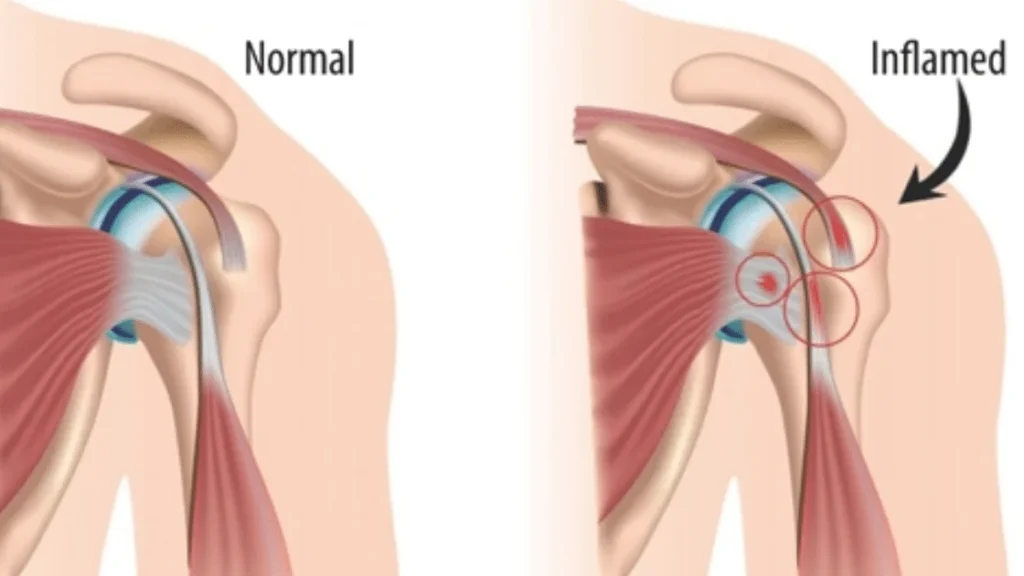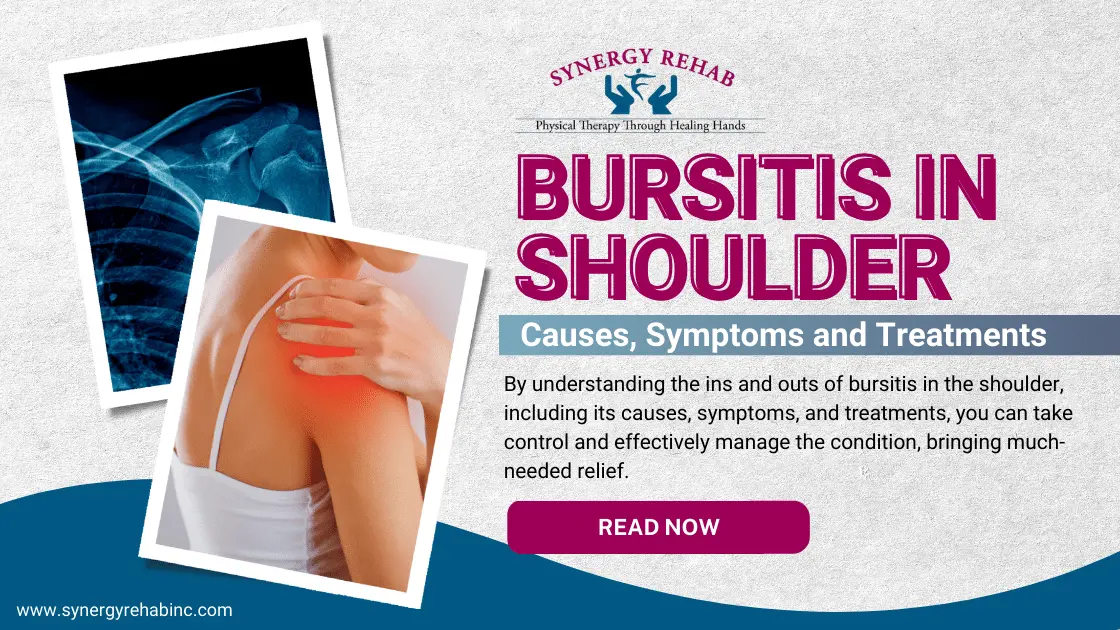Bursitis in shoulder can be a real pain, quite literally. This condition, often caused by repetitive motions or prolonged pressure, can make simple activities challenging and uncomfortable. However, by understanding the ins and outs of bursitis in the shoulder, including its causes, symptoms, and treatments, you can take control and effectively manage the condition, bringing much-needed relief.
What is Bursitis in the Shoulder?

Bursitis in the shoulder occurs when the bursae, these small fluid-filled sacs that act as cushions, become inflamed. They’re like the shock absorbers of your shoulder, that cushion the bones, tendons, and muscles near your joints. When inflamed, this smooth movement is disrupted, leading to pain and stiffness that can significantly restrict your daily tasks.
Causes of Bursitis in the Shoulder
The most common cause of shoulder bursitis is repetitive motion or overuse of the shoulder joint. This can occur in activities that require frequent overhead movements, such as painting, swimming, or playing tennis. However, it’s not just these activities that can lead to bursitis. Other potential causes include trauma, poor posture, and the natural aging process.
Trauma: A sudden injury to the shoulder, such as a fall or a blow, can lead to bursitis. The trauma causes immediate inflammation of the bursae.
Poor Posture: Having a habit to be in a poor posture for longer hours while sitting or standing, can strain the shoulder joint. This type can lead to major inflammation when the posture has been wrong for a long time.

Age: Our tendons and bursae become less elastic as we age, making them more susceptible to inflammation. Degenerative changes in the shoulder joint can also contribute to the development of bursitis.
Underlying Conditions: Conditions like rheumatoid arthritis, gout, or diabetes can increase the risk of bursitis. These conditions can cause systemic inflammation or metabolic changes that affect the bursae.
Symptoms of Bursitis in Shoulder
Recognizing the symptoms of shoulder bursitis is the first step toward seeking appropriate treatment.
Common symptoms include:
Pain: Sharp or shooting pain, especially when lifting the arm overhead. This pain can be persistent and may worsen with movement or pressure.
Swelling: Visible swelling or tenderness around the shoulder joint. The area may appear red and feel warm to the touch.
Limited Mobility: Difficulty moving the shoulder or arm without pain. You might find it hard to perform everyday tasks like reaching for objects or getting dressed.
Weakness: A feeling of weakness in the shoulder or arm. This can result from both pain and reduced use of the affected arm.
Shoulder Bursitis Treatment Options
Several options are available for treating bursitis in the shoulder. However, physical therapy, particularly manual therapy, is an effective and non-invasive approach.
Physical Therapy for Shoulder Bursitis
Physical therapy is a cornerstone in the treatment of shoulder bursitis. A tailored shoulder pain physical therapy program can help reduce pain, improve mobility, and prevent future occurrences. Key components of physical therapy for shoulder bursitis include:

Manual Therapy: Hands-on techniques that include massage, joint mobilization, and manipulation to reduce pain and improve function. Physical therapists use their hands to apply pressure and manipulate the muscles and joints, which helps alleviate pain and restore movement.
Exercise Therapy involves strengthening and stretching exercises to restore range of motion and build shoulder strength. These exercises improve flexibility, reduce stiffness, and enhance muscle support around the shoulder joint.
Modalities: Ultrasound, electrical stimulation, and ice or heat packs can alleviate pain and inflammation. These modalities can provide immediate relief and help in the overall healing process.
Manual Therapy Techniques
Manual therapy involves specific, skilled hand movements to manipulate muscles and joints. These techniques are particularly beneficial for bursitis shoulder pain because they help reduce muscle tension, improve blood flow, and enhance joint mobility. Here are some manual therapy techniques commonly used:
Myofascial Release: A technique that targets the connective tissue to alleviate pain and restore movement. This involves applying gentle pressure and stretching the fascia, relieving tension and improving flexibility.
Joint Mobilization: Gentle movements to increase joint mobility and reduce stiffness. This technique helps loosen tight joints and improves their range of motion.
Soft Tissue Mobilization: Focuses on reducing muscle tension and promoting relaxation in the affected area. This involves massaging and manipulating the soft tissues around the shoulder to relieve pain and enhance movement.
Home Remedies and Lifestyle Changes
In addition to professional treatment, certain home remedies and lifestyle changes can help manage bursitis shoulder pain:
Rest: Avoid activities that aggravate the pain to allow the bursae to heal. Rest is crucial to prevent further irritation and inflammation.
Ice Therapy: Applying ice packs to the shoulder can reduce inflammation and numb the pain. Ice should be applied for 15-20 minutes several times a day.
Proper Posture: Maintaining good posture can prevent additional strain on the shoulder. Being mindful of your posture, especially during prolonged activities, can help reduce the risk of bursitis.
Ergonomic Adjustments: Modify your workspace or activity patterns to reduce repetitive stress on the shoulder. Using ergonomic tools and adjusting your work environment can help alleviate pressure on the shoulder joint.
Preventing Shoulder Bursitis
Prevention is always better than cure. Here are some tips to prevent bursitis in the shoulder:
Warm-Up: Always warm up before engaging in physical activities. Warming up prepares your muscles and joints for activity, reducing the risk of injury.

Strength Training: Incorporate exercises that strengthen the shoulder muscles. Strong muscles provide better support to the shoulder joint, reducing the likelihood of bursitis.
Take Breaks: Avoid prolonged repetitive movements and take regular breaks. Breaks allow your muscles and joints to rest and recover.
Posture: Maintain good posture during activities to reduce stress on the shoulder. Proper body alignment reduces strain on the shoulders and prevents bursitis.
The Final Thoughts
Bursitis in the shoulder can be debilitating, but it can be effectively managed with the right approach. Physical therapy, especially manual therapy, offers a non-invasive and holistic treatment option. If you’re struggling with shoulder bursitis, consider consulting a physical therapist who can tailor a treatment plan for shoulder pain physical therapy. By incorporating physical therapy and lifestyle adjustments, you can alleviate pain, improve mobility, and prevent future occurrences.
If you’re in Southfield, Michigan, suffering from shoulder bursitis, Synergy Rehab can help. Our team of skilled physical therapists specializes in manual therapy and personalized rehabilitation programs to get you back to your best. Don’t let shoulder pain hold you back any longer—contact Synergy Rehab today to start your journey toward recovery.



